It is a common debate among cyclists (and mechanics) which is the best bicycle bearing grease – for use in hub, or steerer, brake pivot etc. bearings. Some swear by the old “axle grease” that “… my grandfather / father used …” Others recommend silicone, Teflon, graphite grease and so on. This post explains important characteristics of various greases in terms of lubricating bicycle bearings.
First there will be a few words about basic construction of bicycle bearings, lubrication requirements and types of loads that bicycle bearings take. Type of bearings and loads it takes are an important factor when selecting lubricants. Then basic characteristics of greases will be explained – in general, with standards for labelling greases explained (so that label can be understood when shopping for grease). Finally, an overview of most commercial greases types available, with advantages and disadvantages for bicycle bearing lubrication use. For simple, non-technical recommendations, look at this post: The best bicycle bearings grease. Related posts are explaininig: Bicycle hub overhaul procedure and Bicycle bearing types and designs.
Note: for mounting things (bolts, seatposts, handlebars etc.) – that is for things that are not made to slide when used, many people use grease, while it is preferable to use anti-seize / mounting pastes (as explained in that linked article). This post deals with greases in terms of lubrication primarily.
0. Disclaimer
All the information provided in this article, as well as on all of my websites, is to be taken as: “to the best of my knowledge”, or “as far as I know”. I have consulted experts of various fields (and still do), including mechanical engineers, especially when writing on this, rather “can-of-worms” topic, and info provided on my websites does agree with my practical experience, but it still is my opinion – based on my knowledge, education and experience. Different people, including experts, have different experiences and, often, different opinions. I’m sure there are, and will be, people who completely, or partially disagree. Even more often – there is and will be data (experiments, statistics, publications etc.) that might contradict, or seem to contradict my work when read/interpreted by a non expert. All of this is normal and to be expected.
People’s reactions to this particular article seem to range from taking it as a gospel, to taking it as blasphemy. Still – it is no more, and no less than: “what I have learned (through theory and practice) so far”. And, like all the other articles, it gets updated as new knowledge is acquired.
1. The loads bicycle bearings take
Bicycle bearings, whether on wheels, cranks, or fork, are usually ball bearings, i.e. they consist of balls, trapped between two races. These bearings are almost never made to be easily re-lubricated from the outside, without disassembling them, so frequent lubrication would take a lot of time.
Since bikes are ridden outside, bearing lubricant needs to keep dirt and water from entering. It should be resistant to being washed off with water, prevent corrosion, while operating temperature ranges from as cold as -20 °C for winter use (though some cyclists are even more extreme), to about 100 °C for bearings of bikes left in hot summer sun, then ridden.
Those bearings need to cope with the load of under 200 kilograms (usually). The load is dynamic, so that impacts can drastically change the volume. However, due to the low weight of a bicycle, only human strength of it’s rider, as well as the fact that a bicycle carries a maximum of two people (specially designed tandems), the forces that occur and bearing loads are relatively small compared to similar in cars, motorcycles, or industrial machinery.
Another important thing is the speed. When a bicycle is ridden around 30 km/h, wheels turn about 250 times per minute (250 rpm). Pedals are rarely turning faster than 100 revolutions per minute, while the steerer bearings rpm is much lower. Also, the distances traveled by bearing balls are relatively small due to the small diameter shaft. When the tyre travels around one meter, hub bearings cover a distance of under 10 centimeters.
So the weight and the speed with which bicycle bearings are loaded are quite modest. While frequent re-lubrication is not practical.
2. Oil as a bearing lubricant
It is quite popular, especially among road bike racers, to pour oil into the bearings (particularly the hubs). The logic is that oil generates much less rolling resistance compared to grease, because it is much “thinner”, more liquid. For the same reason, the oil leaks out easier and is less efficient at keeping dust and water from penetrating the bearing.
It should also be taken into consideration that the design of a bicycle wheel with a hub in the middle makes the lever by which the force is applied to the hub so large that the drag that hubs eventually produce is practically negligible. Especially when comparing the drag of oiled versus the drag produced by properly greased hubs. Even when each second counts, there are lots of other places where the time can be saved (both on the bike itself, as well as with the equipment), while the hubs should be the last thing to experiment on. Of course, everyone chooses by themselves, for themselves, but if hubs are lubricated with oil, it should be noted that this should be repeated every week, or every 500 kilometers ridden – whichever of the of the two comes first.
3. Greases
Before explaining grease types and properties, it needs to be said that there is no such thing as the best grease. There is only optimal choice grease. Optimal as best satisfying all the important criteria. For example: if a grease has best characteristics for lubricating bicycle bearings, but is outrageously expensive, it will not be an optimal choice as long as there is a significantly cheaper grease that has sufficiently good characteristics for the application.
3.1. Attributes that bicycle bearing grease should have
Greases are semi-solid lubricants, used when oils, or liquid lubricants are not appropriate. Either because of higher costs, or for technical reasons. As it was briefly mentioned in previous paragraph, bicycle bearing grease should fulfill the following criteria:
Criterion 1 – Good functioning in a temperature range of -20 to +80 °C. Greases shouldn’t become too hard at the lower, nor become liquid at higher use temperatures. As will be explained, greases that fulfil this criteria need to have a dropping point of at least +100 °C (for hot climates better +120 °C), and the lowest operating temperature (“use temperature” in the remainder of this text) of at least -20 (for cold climate cycling preferably -30 °C).
Criterion 2 – Good corrosion protection and oxidation resistance
Criterion 3 – Good resistance to water wash out and to water and dirt contamination. Per standard ISO 6743-9 at least level E, or better of water resistance. Bicycle bearings are usually not submerged into water, nor is water sprayed on them under pressure. That is why they don’t require water protection levels as some other bearings, e.g. boat trailer wheel bearings.
Criterion 4 – Compatibility with (plastic, or rubber) dusters that some bicycle bearings have.
Criterion 5 – Keeping stable structure and hardness for a longer period of exploitation. Re-lubing bicycle bearings more often than once a year is highly impractical.
Criterion 6 – It should pass 4 ball weld test with weld load over 1000 N.
Criterion 7 – Low price. Out of two greases that both satisfy previously noted criteria, it makes sense to choose the cheaper one. It makes no sense for lubrication, in a medium term, to cost more than replacement of a bearing.
Listed criteria will be used in the remainder of this post note by their numbers. Crit. 1, crit. 2 and so on.
3.2. Grease types division
Most greases (exceptions will be noted and explained) consist of three basic parts:
- Base oil (70 – 90%) – that actually lubricates
- Thickener (3 – 30%) – that keeps the grease hard, holding base oil in suspension and preventing it from leaking out
- Additives (0 – 10%) – that increase beneficial and suppress unwanted attributes of used base oils and thickeners
Even though thickener is what most often gives a grease it’s name (e.g. lithium grease, calcium grease etc), base oil is what does the actual lubrication and usually makes for over 80% of the grease volume. Greases can be divided according to the following criteria:
- 3.2.1. according to base oil type
- 3.2.2. according to thickener type
- 3.2.3. according to intended use area
- 3.2.4. according to exploitation temperatures range
- 3.2.5. according to capability to bear high loads, extreme pressures
Some division criteria are “overlapping”, i.e. different types of base oil can be used with one type of thickener, in order to achieve different grease characteristics. For example, lithium soap based thickener can be used with either mineral, or synthetic base oils to achieve different grease characteristics. In addition to that, in either of the mentioned combinations, another additive can be combined, like molybdenum disulfide for example, in order (in this case) to improve grease’s resistance to extreme pressures, or (extremely) heavy loads.
Before grease divisions are given in detail, picture 1 might seem a bit unclear, but it will help for all the data to fall into place. Thickener type is what practically defines a grease type.
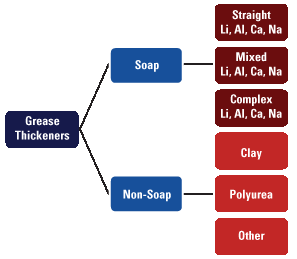
Grease types graph
3.2.1. Base oil type division
- Mineral greases. With mineral base oils. Mostly used.
- Synthetic greases. With synthetic base oils. Usually have properties superior to other comparable greases. With a (significantly) higher price.
- Biodegradable greases. Usually made with beet oil. Used where quick biodegradation of lubricant is needed
3.2.2. Thickener type division
- Soap greases. Soaps are usually made by saponification of fatty acids with hydroxides of various metals – aluminium, calcium, sodium, barium.
- Complex (soap) greases. These greases are more of a subgroup of soap greases when dividing according to thickener type. Soaps with long fibres are resistant to mechanical loads, but don’t hold oil in suspension very well, while soaps with short fibres hold oil in suspension well, but don’t take mechanical loads as well. That is why complex greases are made as a combination of (the same metal) soaps that hold oil in suspension well, and soaps that have good resistance to mechanical loads.
- Mixed soap greases. Similar to complex greases, except two different metal hydroxides are used, usually lithium-calcium, or sodium-aluminium. They have superior characteristics to other soap greases (even complex ones), but their price is higher, they are less easily available and are seldom used.
- Non-soap greases. They don’t contain soaps, nor oil that soaps hold in suspension. Non-organic silicone, or bentonite, or organic polyurea.
Table 1 shows grease division and characteristics according to thickener type. Note that maximal use temperature is significantly lower than dropping point temperature (at which grease becomes practically a dripping oil).
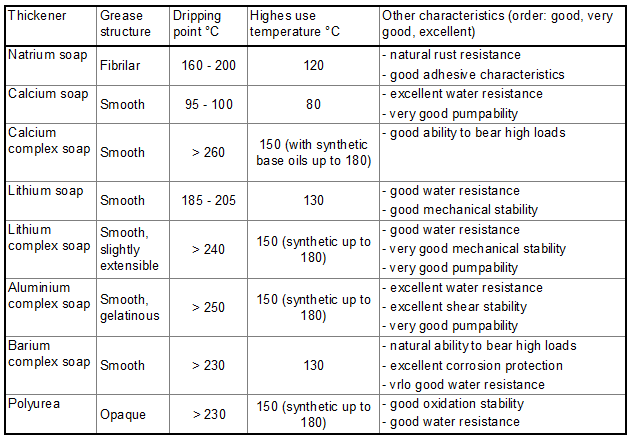
Grease characteristics according to thickener type
3.2.3. Intended use area division
- Universal (general purpose) greases
- Special greases with added solid lubricants, such as graphite, or molybenum disulfide (MoS2). Usually used for high load and pressure bearing greases. Special additives, when they are not needed, in addition to increasing the price, can have a negative affect on grease properties for the intended use!
- Greases for roller and plain (slide) bearings.
- Sprocket greases
3.2.4. Exploitation temperature range division
- Low temperature greases – for working temperatures (well) below -20 °C.
- Normal temperature greases – for temperatures from -20 °C to +100 °C.
- High temperature greases – for working temperatures that in a prolonged period of time stay above +100 °C (often even +200, or over +300 °C in some cases).
3.2.5. High load and pressure bearing capability division
- Greases for normal loads and pressures
- Greases that can bear high loads and pressures, i.e. with EP (Extreme Pressure) additives. Just like special additives, greases with EP additives shouldn’t be used when EP characteristics are not required.
3.3. Grease labeling according to standards
3.3.1. Grease consistence (hardness) labeling according to NLGI standard
Standard for labeling grease consistency is established by American non-profit, independent NLGI (National Lubricating Grease Institute) organization.
Consistency (hardness) is measured with a cone, by methods standardized under ASTM 217 IP 50, or DIN 51804, part 1. Measuring unit represents depth the measuring cone enters the tested grease. Testing procedure is shown in the picture 2 below.
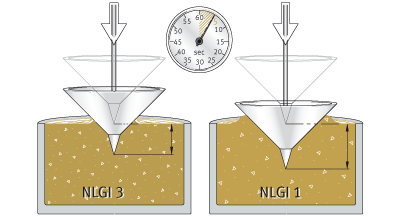
NLGI testing and measuring
In plain English, grease is held at a temperature of 25 °C. It is well meshed (standard prescribes 60 meshing cycles). Then the surface is put in a container, top surface is smoothed over, and a cone shaped plunger is slowly placed from the top to dig into the grease with it’s own weight. Diameter of the hole imprinted by the cone is then measured in tenths of a millimeter. Standard is shown in table 2.
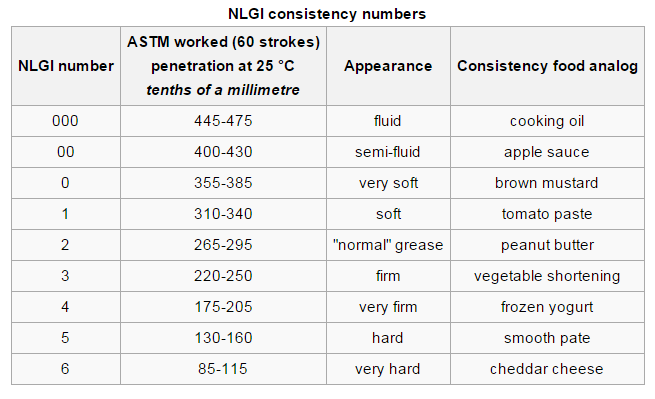
3.3.2. Grease labeling according to ISO standard
According to international standard ISO 6743-9, greases are divided per intended use conditions. Example of an ISO label:
ISO 6743-9: ISO-L-XCCHA 2
Meaning of each letter is given in table 3.
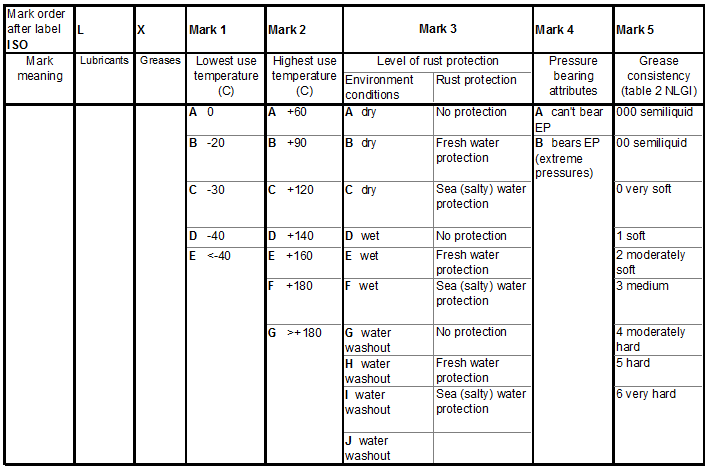
Grease labeling according to ISO standard
3.3.3. Grease labeling according to DIN standard
German DIN 51 502 standard for labeling greases, unlike ISO, with legendary German precision and efficiency sorts greases according to base oil types, additives etc, so there can be no confusion when choosing the appropriate grease for a given application. 🙂 Example of a DIN label:
DIN 51502: K2 K-30
Meaning of each letter is given in the tables 4 and 5.
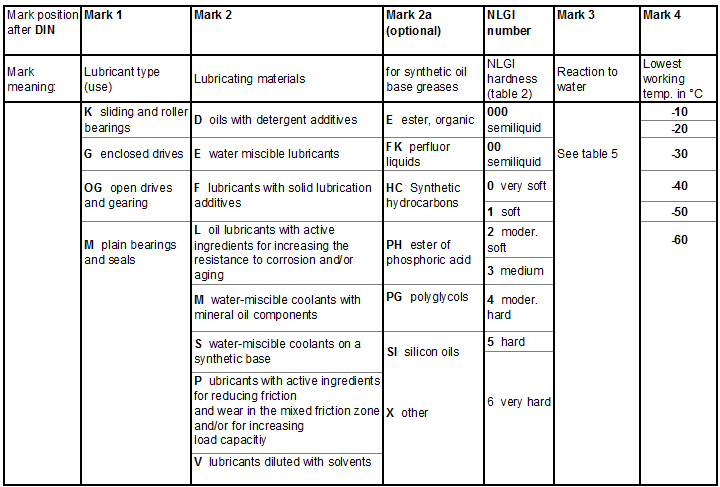
Grease labeling according to DIN standard
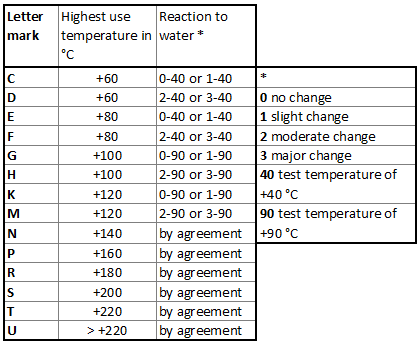
Reaction to water according to DIN standard
Note:
Mark 2 in table 4 is used only if a grease has some of the ingredients/properties listed in that column – otherwise, the mark is omitted.
See the “Bike greases questions” discussion on the BikeGremlin forum for a bit more details on this.
4. Solid (state) lubricants
Solid lubricant is a material used as a dust, or a thin film layer, to protect adjacent sliding surfaces and reduce wear and friction during their relative movement. In practice, solid lubricants are often suspended in oils, or added to greases (see 3.2.3. special greases).
Solid lubricants are used in extremely high, or low temperatures, extreme pressures, sudden and great variations of loads, hardly accessible parts, parts that can not be regularly re-lubed, corrosive environments, vacuums, or high speed moving parts. Solid lubricants are also practical in conditions where dirt, dust, or sand occur in amounts that could cause problems, because they aren’t as sticky to collect much dirt. They can also fill in gaps between partially worn parts, prolonging the replacement period. Solid lubricants are also used to ensure good running in, instead of wear of recently machined metal surfaces.
4.1. Solid lubricants division
Solid lubricant groups most commonly used are lamellar solids, polymers and soft metal films. In addition to noted, there are some more, better to call them subgroups of solid lubricants, such as multipurpose solid lubricants, combinations of ceramics and solid lubricants, materials made of glass etc. Those lubricants are usually used for extreme and special conditions and temperatures over 1000 °C, to they will not be explained in a post that is about bicycle bearing greases.
4.1.1. Lamellar solids
Graphite. Has low friction coefficient, but use (and maximal use temperature) is limited because in order to minimize friction, it needs to absorb some moisture. It also has a high electrical potential of +25 V, so can cause strong galvanic corrosion of copper and stainless steel alloys in salty water. In practice it is used for temperatures up to 600 °C.
Molybdenum disulfide (MoS2). Like graphite, has low friction coefficient, but doesn’t need to absorb moisture to achieve it (moisture with MoS2 can even somewhat increase friction). Has higher load bearing capabilities than graphite. In environment with oxygen, it can be used for temperatures under 400 °C, while in a non-oxidant environment it is stable up to 1100 °C.
4.1.2. Polymers
Polymers are used as thin lubricating films, as self-lubricating materials for elements manufacturing and as a bonding material for lamellar solids. The most famous polymer solid lubricants are tetrafluoroethylene (TFE), a gas without colour and smell, which with polymerization gives polytetrafluoroethylene (PTFE). PTFE is registered under the (often used) name of Teflon, by DuPont company. One of the most slippery materials on the planet, with a friction coefficient similar to wet ice sliding over wet ice. 🙂
Main advantages of PTFE are low friction coefficient and wide range of working temperatures, from -200 °C to +250 °C. Disadvantages are a higher price and inability to bear high loads.
4.1.3. Soft metal films
Many soft metals, like copper, silver, gold, zinc, lead etc. have low shear resistance and can be used as a lubricant, put in a thin layer over sliding hard surfaces. Soft metal films are useful for tempereatures up to 1000 °C, but are less often used nowadays.
4.2. Comparative review of solid lubricants
Table 6 gives a comparative overview of some commonly used solid lubricants. As can be seen, MoS2 satisfies most criteria and that is why it’s most commonly used, often as an additive to greases.
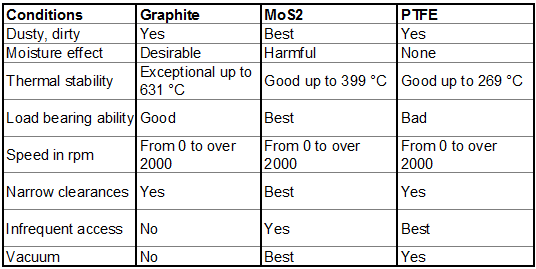
Comparative review of solid lubricants characteristics
5. List of various greases available on the market, with usual characteristics
Having explained grease type division in paragraph 3, this paragraph explains some produced and available greases, as combinations of thickeners, base oils and (sometimes) additives. As will be seen, thickener type is usually what gives a grease it’s name, with additives (especially in case of solid lubricants) noted as an appendix.
“Usual characteristics” in the heading is written because various manufacturers (and concrete grease models) use various ingredient qualities, so final product characteristics may vary. Concrete characteristics a finished grease possesses is usually written on the label, either in the form of a marketing slogan, or (more reliably) by noting DIN and/or ISO standard that a grease complies with. Characteristics like lowest and highest use temperature, water washout resistance etc.
5.1. Calcium greases
They are widely used and available. Basic calcium greases have low price. Calcium thickener provides the grease with an excellent water resistance. These greases have a relatively narrow working temperature range. I.e. if bicycle is ridden below -20 °C, or it stays in hot summer sun before riding (over +35 °C), then they are not the best choice.
Of important criteria listed in paragraph 3.1. these greases only have problems with fulfilling Crit. 1. (for extreme conditions of bicycle use), while Crit. 3. is probably best satisfied of all the other grease types, except some enormously expensive ones.
5.1.1. Complex calcium greases
Somewhat improved characteristics than ordinary calcium greases. They usually have a higher maximal working temperature (check the label) so they are good for extreme summer heats.
5.1.2. Axle grease
Marketing name for basic, very cheap calcium grease. Slightly lower working temperature range than “ordinary” calcium grease, so not best used for bicycle bearings, but it will do in a pinch.
5.1.3. Marine grease
Grease used for (and marketed as) boat trailer wheel bearing lubrication. Bearings that need to be submerged into sea water when boats are put into the sea. Very good corrosion and water washout resistance. Use temperature range is similar to ordinary calcium greases (if it is complex, then like complex calcium greases). Relatively low price (similar to calcium, or complex calcium greases).
5.2. Lithium greases
Most widely used grease type. Widely available, at a low price. Fulfills all the criteria a bicycle bearing grease should satisfy. Water and rust resistance is not as good as that of calcium greases, but it is more than good enough for bicycle bearing application. Wider use temperature range than similar calcium greases. In case of high quality synthetic base oils, temperature range is even greater, though this raises the price significantly, without much measurable benefits for use with bicycle bearings. Perhaps for extreme (-40 °C cold) uses.
5.2.1. Lithium complex greases
Somewhat wider use temperature range than ordinary lithium greases (completely irrelevant for bicycle bearing lubrication use). Usually have better resistance to corrosion and water washout, similar to that of calcium greases.
5.2.2. Lithium complex EP greases
Same as lithium complex greases with EP (extreme pressure) additives. In fact, lithium complex greases are almost impossible to find manufactured without EP additives. These additives are not needed for bicycle bearing use. With greases, all that is not needed is usually harmful, but in this particular case, no measurable harm comes from the EP additives. They can increase corrosion of coloured metals and silver, but with steel bicycle bearings they are mostly harmless™. Better without them, but no problems with them.
5.3. Greases with graphite additive
Graphite is added to a grease as a solid lubricant, to improve extremely high load bearing characteristics. It is usually combined with calcium, or aluminium greases. Bearing extremely high loads is completely needless attribute for a bicycle bearing grease. You will needlessly pay more, with no measurable practical (or even theoretical) benefits.
5.4. Greases with molybdenum disulfide (MoS2) additive
Similarly to graphite additive greases (5.3.), excellent for high pressures and temperatures, with no negative impact on bicycle bearings. So lithium, or calcium greases with MoS2 won’t be bad for bicycle bearings, just needlessly expensive.
Exception where MoS2 greases are useful can be coaster hubs (hub brakes), where excellent heat resistance can help grease hold it’s own better. However, there are significantly cheaper, almost as good alternatives, like lithium complex greases.
5.5. Greases with Polytetrafluoroethylene (PTFE, “Teflon”) additive
PTFE is usually added to lithium grease. These greases differ from “teflon” greases, where PTFE is used as a thickener (with a synthetic base oil usually), not as an additive. PTFE improves grease performance with high speeds (measured in thousands of revolutions per minute). With greases for lubing bicycle bearings, PTFE as an additive needlessly increases grease price, but doesn’t harm (nor does it benefit) grease’s performance (not even in theory).
5.6. Polytetrafluoroethylene (PTFE, “Teflon”) greases
Greases where PTFE isn’t an additive, but a soap (or combination of PFTE/PFPE soaps), that keeps base oil in suspension. Harder to find, more expensive, less compatible to mixing with other commonly used greases (see paragraph 6.). Apart from that, characteristics are good for lubricating bicycle bearings.
5.7. Lithium-calcium complex greases
Combination of complex lithium and calcium soaps thickeners. With quality base oils these greases can be made to be superior to complex (even more so compared to ordinary) whether lithium, or calcium greases. They are less easily available and higher priced though – with no measurable benefits for use in bicycle bearings compared to quality lithium soap based greases.
5.8. “Silicone” greases (soap greases with silicone oils)
Silicone oils suspended in a soap of lithium, calcium, PTFE, fumed silica etc. Lithium soap based silicone greases have excellent properties for lubricating bicycle bearings, but are outrageously expensive. Because there are greases that cost a lot less, while being good enough, and because it makes no sense for lubrication after a few seasons to cost more than a new bearing, silicone greases are not an optimal choice.
5.9. Aluminium and aluminium complex greases
Not to be confused with aluminium anti seize pastes. Similar to lithium greases, with better water resistance (similar to calcium greases), but with a significantly higher price.
5.10. Sodium greases
Poor resistance to corrosion and water washout, so not good for lubricating bicycle bearings.
5.11. Barium and barium complex greases
Good water resistance, high dropping point, but limited low temperature use (slightly worse even than calcium greases). Very high price. Barium and many of it’s compounds are toxic!
5.12. Silica greases – non soap base greases
Greases without a soap. Thickener is amorphous fumed silica. Silica greases posses good oxidation resistance and thermal stability, good resistance to water and acid washout, while their hardness doesn’t change with the change of temperature. Because of a high production price and limited high load bearing capacity, silica greases are limited to high temperature grease use.
5.13. Bentonite greases – non soap greases
As a thickener, modified clay – bentonite – powder is used. Greases for high working temperatures. High price and incompatibility with most other grease types make this grease not the best choice for lubricating bicycle bearings.
5.14. Polyurea greases – non soap greases
After describing non soap greases with a non-organic thickener, it is time for an organic thickener one – polyurea. These are usually picked for their good high temperature characteristics (dropping point is over 260 °C). These greases have thixotropic properties (i.e. they soften when lubricated parts are moved, then harden back to original consistency when stationary).
These are high quality greases with excellent lubricating, water resistance, extreme pressure bearing and oxidation resistance properties.
The main flaw when using these greases for bicycle bearing lubrication is it’s relatively higher price. Also, low compatibility with other greases can be a potential problem – in case of adding grease without previous complete washout of the existing grease.
5.15. Copper “grease”
Quotation marks because it actually is an anti-seize (mounting paste) compound. This “grease” is used for high temperatures – lubing sliders of disc brakes, where lots of heat is generated when braking. It is also perfect for preventing parts from seizing together – perfect for lubing seat post, all the bolts and nuts, bottom bracket threads – it will prevent metal from binding together, but not be too slippery to ask for a lot more torque when screwing in. As an anti seize it is one of the most effective products. However, for bearings themselves, it is too hard, to thick.
6. Grease compatibility
Now that grease types and solid lubricant (additives) types have been explained, it is clear that there are numerous possible combinations. For the purpose of re-lubing an already lubed bearing, if completely washing out old grease is not possible/practical, it is important to know which greases (with which additives) are compatible (i.e. can be mixed) with which greases.
As a general guide, one can use the following: greases with the same types of thickeners and similar base oils are usually compatible (e.g. lithium grease with another lithium, or even lithium complex grease). Table 7 shows grease compatibilities based on thickener compatibility, while table 8 shows base oil compatibility. Both compatibilities should match in order to safely mix the two greases.
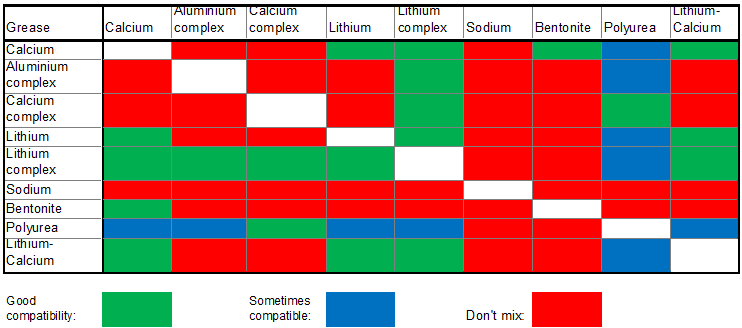
Compatibility of various types of greases
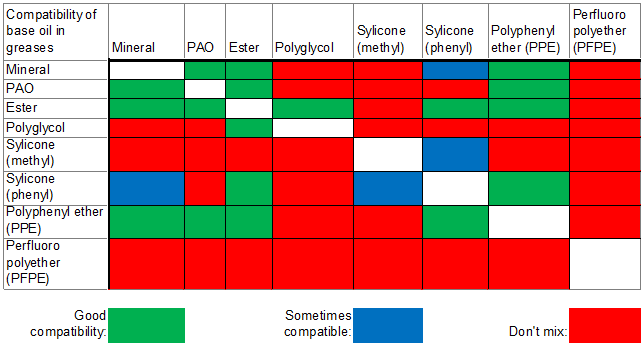
Compatibility of grease base oils
7. Recommendation of a bicycle bearings grease
Recommendations in this paragraph are author’s personal opinion based on knowledge and experience.
First some general guides will be given, then with more specific grease types.
- Optimal hardness for a bicycle bearing grease is NLGI 2, whichever grease type is chosen.
- General recommendation would be an ordinary lithium (soap based) grease. Available, cheap, with characteristics that satisfy all the criteria for this use. It hardly makes sense using anything else. Even those satisfying ISO water resistance standard with H level are not too expensive.
- If riding environment has lots of rains and/or sea water, good choice is calcium (soap based) grease (or “marine” grease). Available, cheap, with good water resistance. The only situations where this grease is not a very good choice are extreme heats (bike left for hours in over +35 °C summer sun), or riding in very low temperatures (below -15 °C).
- For a wide range of working temperatures (for -25 °C to hottest Africa heat), with very good water resistance attributes, but not too expensive – lithium complex grease with ISO water resistance level I. With, or without EP additives (doesn’t really matter). Still, this grease costs about double the price of ordinary lithium, or calcium based greases.
- For deep freezing temperatures, below -30 °C: choose either calcium, lithium, or calcium-lithium (mixed) grease, whether plain, or complex, with noted lowest working temperature of at least -40 °C (preferably -50°C).
- For coaster brake hubs (hub brakes) – good choice are greases that can withstand high temperatures (generated when braking). Lithium-complex soap based greases, or (if not sparing money, or they are already at hand) – lithium complex with molybdenum disulfide (MoS2).
Special types of “bicycle grease”, sold in many bike shops, or on-line rarely have a label noting standards it satisfies, often even don’t have fully and clearly listed ingredients. It’s up to the buyer to trust the manufacturer that it is the best grease for a bicycle. I’m yet to do lab testing of “special bicycle greases”, but when I do – they’d still have to be really, really exceptional to justify the price difference from a regular car-store sold lithium soap based grease, that fully satisfies all the criteria.
Author’s recommendation of greases from Amazon.com on-line shop (clicking on an image below opens Amazon affiliate link for on-line shopping). As an Amazon Associate I earn from qualifying purchases.
Note: listed greases are the ones I could find that are of good quality and with a world-wide distribution. Feel free to look for cheaper, locally available options. My 1st choice is local, Serbian made FAM FORPLEX 2 grease.
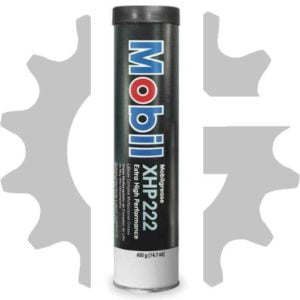
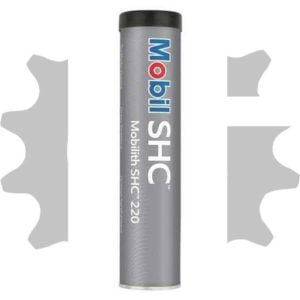
Update, December 2023:
Grease I’ve been using mostly over the past year is Motorex 2000 grease (also sold as “Motorex Bike grease”). Why? It is “officially” (by the manufacturer’s specifications) neutral towards plastic and many kinds of rubber (not to be used on DOT for brake rubber seals though). And it has a nice colour, but is mostly transparent, so I can easily see where and how much I’ve applied. 🙂 It is needlessly expensive for what I’m getting, but since I often work on other people’s bikes, and bikes are getting more and more plastic and carbon parts, I want to minimize any liability. This grease is calcium based.
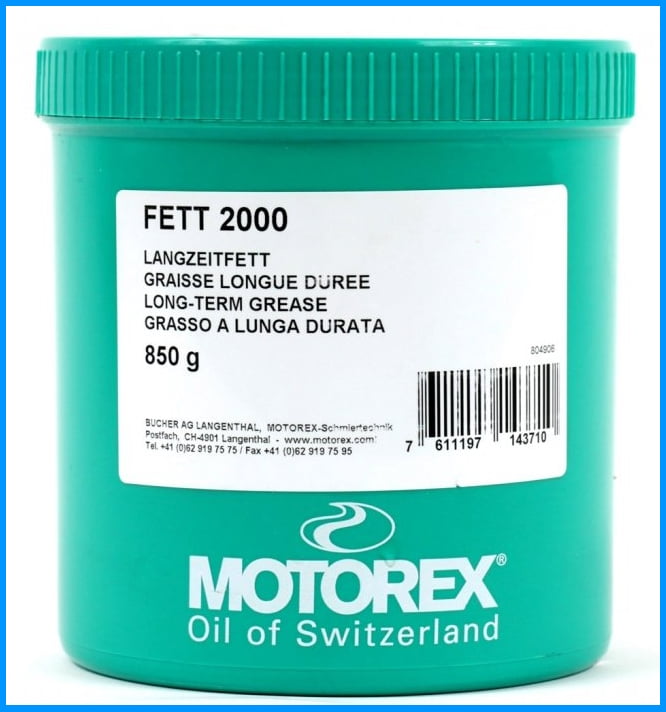
8. Sources
- https://motornaulja.blogspot.rs/
- http://www.maziva.org/izbor-maziva/mazive-masti/
- http://www.axelch.com/wordpress/wp-content/uploads/2014/12/WhitePaper-16.pdf
- https://bobistheoilguy.com/functions-of-grease/
- Rolling Bearing Analysis – Tedric A. Harris (Amazon affiliate link, I’ve used a borrowed, older, 4th edition)
Coauthor:
Stevan Dimitrijević (dr of metallurgical engineering)
Author of the greatest site (blog) in serbo-croatian language about motor oils and lubricants:
https://motornaulja.blogspot.rs/
Last updated:
Originally published:
Related post – Types and designs of bicycle bearings:

If you have any questions (or additions and corrections), please use the BikeGremlin forum – this is the forum topic related to this article:
https://www.bikegremlin.net/threads/bike-greases-questions.64/
The existing comments posted under this article (questions and answers) have been moved to this BikeGremlin forum thread:
https://www.bikegremlin.net/threads/bicycle-bearing-greases-explained-article-comments.105/

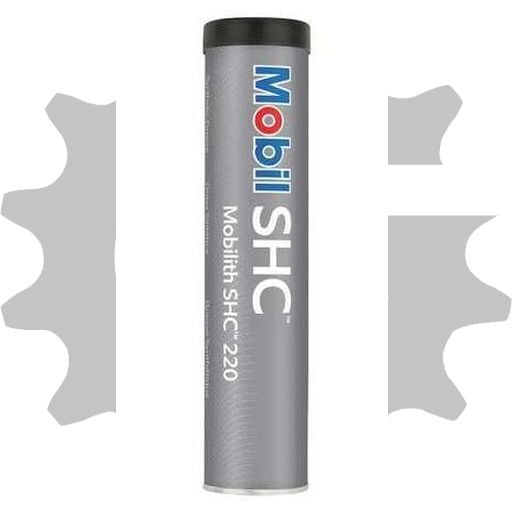
i ‘ve even tried nlgi 0 grease but as you can guess leaked pretty good at high reps.
i’ve been using 1 and 1.5 for years now , and i have an electric spinner that uses 25x37x7 bearngs. Pretty similar to what shimano uses in their hollowtech bottom bracket. the spinner goes to 30,000 rpm and nlgi 1 hasn’t leaked not once. A bicycle bottom bracket can max out at 100 per minute, so it is impossible to displace grease. But if someone, for some reason see leaked grease than it is certain that he or she has overgreased it. That is also why i included grease nlgi 1.5, if someone doesn’t feel confident with nlgi 1, he/she can go with nlgi 1.5 and be done with it.
And like you said above, performance wise, it is better to know how much grease to implement rather than the thickness itself.if you overgrease , the balls tend to slide than to rotate , but at 25%, the balls start rotate smoothly and not slide.
you wrote something above. That nlgi 1 doesn’t hold bearings well enough. Are you referring to loose bearings? because in newer years there are no loose bearings anymore and the cage their in hold themin place.
In my opinion, the main problem with using too much grease is bearings overheating.
For 30,000 RPM, grease hardness and amount have a lot more significant impact.
Rotation speeds seen with bicycles are ridiculously low in that account, so that is not a worry. Not even with wheels (and even much less so with bottom brackets, or steering – headset – bearings).
For bearings – yes, by “cup and cone” I meant the “loose ball bearings”. The ball holding “power” is relevant to those only. As for the “no loose bearings anymore”: how many people use them is not relevant for any particular person choosing grease – because one chooses for their own application. For example, I like Shimano hubs (price/quality ratio and availability are the least bad for those in my region), they are still using cup and cone (loose ball, angular contact) bearings. Also, most bicycle wheels in my city are still cup and cone (either Shimano, or Quando hubs – well over 50%) – and same goes for most headset bearings and still a relatively high percentage of bottom brackets (some 5 to 10% of the bikes I see have cup and cone bottom brackets… yes, ancient tech and rather poor quality – my road bike included).
Those using cartridge bearings needn’t be concerned with that, of course.
Also, from the experience with yearly wheel bearing overhauls (for cup and cone bearings), even the “MTB hubs” (that are supposed to be a bit better sealed than the “road hubs”), don’t hold the softer grease well enough. Sure, it also depends on the grease quality, but from my (and the mechanics I’ve discussed this with) observations, softer greases get “lost” from the bearings more quickly.
In addition to that, I haven’t noticed any problems with using NLGI 2 grease. Lubrication, water washout resistance, even drag – none. On the other hand: price, availability and convenience (if servicing loose ball bearings) – all go in favor of NLGI 2, at least in my region.
Having said all this – there’s nothing wrong with NLGI 1. Loads that bicycle bearings take do not require NLGI 2 grease. The most important thing is regular service (and dirt intrusion prevention – but that’s down to the bearing / hub manufacturer mostly).
Many thanks for the informative article.
I’m a professional bike mechanic and always used (out of habit) medium hardness lithium “green” grease, which is what you also suggest. I would be interested however in more considerations on lithium vs calcium soap as there seems to be little difference between them according to your data, but I had bad results with reddish-brown calcium greases in practice (washout and aging) however it was with cheap all-purpose products whereas the lithium soap ones in the shop are branded. Also does colour have a reliable meaning? I and some colleagues go with the colour traditionally.
ps small typo: rpms of a wheel at 30kph would be around 250 not 500 you might want to correct that
First to thank you for the correction – I find such input invaluable, in order to improve all the data. Re-checked twice: 250 it is. Probably had forgotten to divide the number of meters per minute with the wheels circumference (which I rounded to 2 meters).
As for the greases, good quality calcium based ones aren’t bad. Not much worse than good quality lithium based ones.
Even better are complex “versions” – both lithium complex and calcium complex greases.
I use relatively cheap all-purpose lithium complex grease and it’s performed very well over the years – both with mine and customer bicycles.
Can’t really say I’ve noticed the colour to have any relation to greases quality. Didn’t pay much attention to it though. Thinking, retrospectively, some of the more expensive (synthetic based) lithium complex greases I’ve used were of red colour, with a relatively clear texture (“clear” as coca cola texture vs muddy water texture). But that could be just marketing.
Washout and aging is a problem with both calcium and lithium greases – complex versions (all else being equal) seem to be better at staying “greasy” and staying in place.
Thank you very much for the knowledge. It is clear that lithium-based grease is the best, but what to do in cases where there are rubber or seals. Is it true about the deterioration of these with lithium-based grease? What would be the alternative, calcium grease?
MY doubt is specifically focused on the lubrication of shimano m8020 pedals that have a rubber seal
Nitrile and polyurethane rubber is not too sensitive to petroleum based lubricants. With those, general lithium based grease (with mineral oil lubricant) should be fine. I can’t say what kind of rubber seals are used by Shimano, but didn’t have any problems with Shimano rubber hub seals while using lithium grease, for example. I’d go with that (complex lithium grease).
Generally “rubber friendly” greases are:
PTFE greases (where PTFE is used both the soap keeping the lubricant suspended and the lubricant) are safe for most rubber types for all I know (though quite expensive).
Or Silicone greases, where the lubricant is silicone oil held in suspension by silica or PTFE.
Consulting manufacturer tech. specs can also be useful:
https://www.super-lube.com/Content/Images/uploaded/documents/Compatability%20Charts/Super%20Lube%20Multi-Purpose%20Synthetic%20Grease%20with%20Syncolon%20(PTFE).pdf
Hello. Big thanks for amazing technical article. No other alternativies in internet.
I have couple questions.
First. Some days ago I bщгпре a calcium grease Motul Nautic Grease. It has temperature range from -30 C to +120 C. Also I have bicycle lithium TF2 Grease with temp. range from -20 C to +120 C. In this case calcium grease has better temperature range than lithium grease. But in article “These greases have a relatively narrow working temperature range. I.e. if bicycle is ridden below -20 °C, or it stays in hot summer sun before riding (over +35 °C), then they are not the best choice”. I ride in any temperature range (-30 – +35) and in any weather conditions. Also salt protection is very matter for me becouse salt applied to roads to protect against ice. So is my choose enough good and calcium grease have better temp. range than lithium grease?
Second. What to use on bearing seat before pressing pivot bearing in links? I saw in GMBN youtube channel they used Parktool grease. In White Bikes, Marine Bikes and Specialized frame manuls sayed to use Loctite 608/638/641. It is very expensive in my country it costs about 35$ for 50 ml. For comparision Motul Nautic Grease costs 9$ for 400 ml.
P.S. sorry for my poor English. It’s not my native language.
Hello,
There are thousands of different products – article was aimed at providing some guidelines, with “rule of thumb” properties. Motul and Mobile, to name a few, make some exceptional quality greases (and sell them at premium/higher prices).
For your riding conditions (intended use), that Motul grease looks like a good choice, if the cost is not prohibitive.
In my city, temperatures rarely go below -20, mostly stay up to -10 in the coldest of months, but as far as salt protection goes (our road companies don’t spare on the salt as soon as there’s any snow), Lithium soap based grease seems to work fine – I also ride all year long.
For pressing in the bearings (not for lubrication of moving parts), I prefer (and recommend) using some kind of anti-seize, not grease. Because it provides long(er) term protection from seizing (corrosion), helping both with mounting and dismounting. Grease can be relied upon for only up to one year, if not even shorter period, for anti-seize protection. Products sold as “copper grease” are quite good for that task.
Relja
While I agree that “Dropping Point”, a proxy for max working temp of a grease, is largely irrelevant, hubs, especially front hubs with disk brakes can get very hot, and is a primary reason the industry moved away from QR hubs for these applications (the skewers would stretch so much under heat they’d open)
Also, headsets would seem to have about zero lube requirements as they move very slowly, but “Pound-Out” is actually very important for headsets, and grease thicker than NLGI #2 could be helpful here.
Finally, NLGI #2, nor greases with high cohesion, would be good for lubing shifter cables. You want the grease to adhere to the cable and the housing, but not itself, and the thinner the better so long as it doesn’t all leak out in the year or so between cable replacements.
I would argue that the main reason for abandoning quick release hubs was a bit different:
Placing the disc caliper behind the fork (a copy of a common design used in motorcycling) results in the braking force trying to pull the hub out of the flanges – downwards.
Motorcycles have been using through axles for ages, so that was not an issue with them. But for bicycles – while the rear disc brake, being placed in front of the axle, in fact pushes the hub deeper into the flanges when braking (where it is locked against the frame), the front one was problematic. Also, when using one, not two front brake discs (weight saving important with bicycles), another advantage of a thru axle is that it does transfer more torque to both fork legs.
So I don’t think that heat buildup was what caused the QR front wheels to get loosened. It was the braking torque that tended to pull the hubs out. And it worked in many small movements, slowly unscrewing the nuts (when there’s any movement, tightened nuts tend to rotate in the “direction” of lower preload, i.e. get loosened). Lever can become open only after the nuts have been loosened enough – because QR mechanism is a self-securing one (more torque is needed to open a lever of a properly tightened one, than it is needed to keep the lever locked). Braking force pulling hub out of the flanges (and rider weight pushing the hub back into the dropouts) provided the movement needed to cause the nuts to start slowly loosening.
I would also add that I haven’t noticed discs transfering a lot of heat to the hub itself. There’s a lot of aluminium and steel there, and when braking is hard, there’s usually a lot of wind and rotation to cool it all down. Would expect the discs to warp from overheating long before hub grease gets hot. Might put this to the test in the summer. 🙂
As for the headsets – what kills them are two things:
1) Dirt intrusion (the main reason why bottom headset bearings get busted a lot sooner than the top ones).
2) road vibrations, as the fork steerer tube flexes – practically moving back and forth, displacing the lubricant. On fast, long road descents, when there’s not enough turning of the bars in order to replentish the lubricant displaced by the vibrations, bearings get fretting damage.
Road shocks (“pounding”) are often a concern – but, as far as I know, a misplaced one, when it comes to headset bearings. In fact – I’d argue that a softer grease, that is more easily smeared/replentished as the bars are turned would probably be a better choice. So I see no reason to use any grease harder than NLGI #2 for this application. Regular service is the best cure for dirt intrusion, while the road vibes and turning of the bars is what it is when one is riding. Can’t really influence that.
Where gear (and brake cables) are concerned – I agree. Suppose it depends on the conditions, but I would generally avoid any thick grease for those. In my climate, both in the summer (with lots of dust), and in the winter, I’ve gotten the best results using a very “thin” oil (marketed and sold as “Motip PTFE lubricant”, though I sincerely doubt there’s nearly any/enough PTFE added to make any difference – but it’s a very good lubricant, that doesn’t attract dirt, and prevents moisture from rusting the cables).
Hubs where grease temperature resistance does get put to the test are hub brake models (coaster brakes, “Shimano Roller brakes” etc.). There, the temps inside the hubs can get really high, especially if braking a lot (long descents etc.).